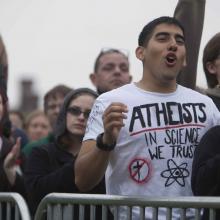Pew Forum on Religion & Public Life
Nearly one in three Americans, including many with no little children at home and those with no religious identity, say they pretend Santa will visit their house on Christmas Eve.
Overall, 31 percent of U.S. adults play up the Santa role in their holiday season, according to a survey released Wednesday by the Pew Research Center.
Jesus, however, is still the star of Christmas.
Six years ago, then-Cardinal Jorge Bergoglio of Buenos Aires attended a gathering of Latin American bishops at the Marian shrine of Aparecida in Rio de Janeiro and called for the Roman Catholic Church to go toward the “outskirts, not only geographically but … existentially.”
Two years after the 2005 papal conclave where Bergoglio was the runner-up to Pope Benedict XVI, the speech helped raise his profile as a man to watch.
Next week, Bergoglio will return to Aparecida and Rio, this time as Pope Francis. Though he won’t visit his native Argentina, the visit will draw attention to Latin America’s first pope and his appeal for a poor church that eschews worldly power.
Nearly half of all Americans — 48 percent — say the growing number of nonreligious people is “bad for society,” according to a poll conducted by the Pew Forum on Religion and Public Life.
But about the same amount — 50 percent — say the rise in nonreligious people is either a good thing (39 percent), or doesn’t matter (11 percent).
The findings flesh out last year’s Pew Forum survey on the “nones,” the one in five Americans who report no formal religious affiliation. But the results also illustrate the divided reactions to this trend between those who are religious and those who are not.
People who hoped the Arab Spring would lead to greater religious freedom across the Middle East have been sorely disappointed, and a new Pew study confirms that the region has grown even more repressive for various religious groups.
“In 2011, when most of the political uprisings known as the Arab Spring occurred, the Middle East and North Africa experienced pronounced increases in social hostilities involving religion, while government restrictions on religion remained exceptionally high,” according to the report by the Pew Research Center.
The study shows the number of countries in the Middle East or North Africa with sectarian or communal violence between religious groups doubled from five to 10 during 2011, a year that coincided with most of the political uprisings of Arab Spring.
Amid calls to get more Muslims using the Internet, experts who have studied Muslims online caution that the virtual Islamic community can be a “double-edged sword.”
While the proliferation of Muslim websites provides a platform for a multitude of voices, Sahar Khamis, communication professor at the University of Maryland, College Park, said there is a shortage in the amount of rational, critical deliberation, and debate taking place online.
The Pew Forum on Religion & Public Life recently released a report suggesting that Muslims who use the Internet tend to have a more favorable view of Western movies, music, and television than their offline counterparts.




